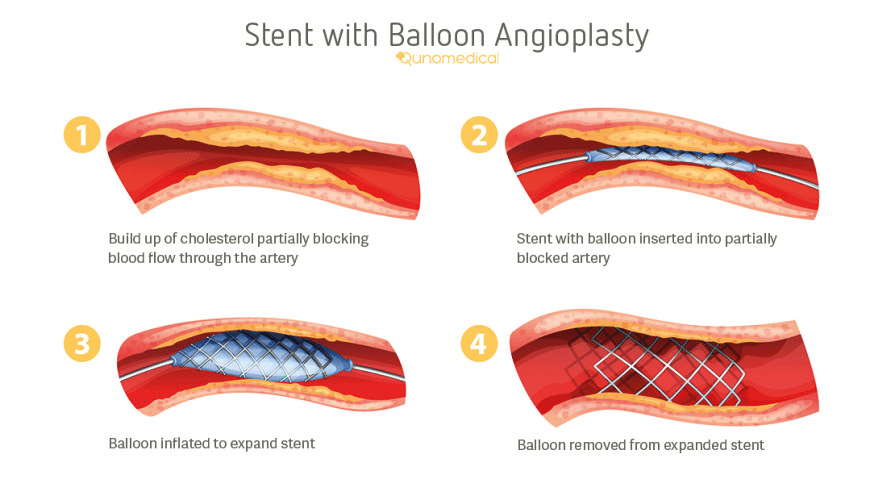Coronary Stent
Most people who have angioplasty also have a coronary stent placed. The stent is usually inserted during the same procedure after the inflated balloon has widened the blocked artery.
The content has been reviewed for quality and accuracy to the best of our knowledge by Qunomedical and its Medical Board of Experts.
 JuliaPatient Manager
JuliaPatient Manager“Qunomedical helped me so much! Thank you!“
“Qunomedical helped me so much! Thank you!“
Gallery
QUICK DETAILS
WHO IS THIS FOR
People with narrowed arteries around the heart.
People with hardened arteries around the heart.
People with coronary heart disease.
People with angina.
People who need emergency treatment following a heart attack.
SUCCESS
Around 90% of patients live for at least five years after an angioplasty.
Around 12% of patients who undergo angioplasty go on to have a heart attack within five years.
TREATMENT DURATION
Depending on how many stents are required and the extent of the blocked or damaged arteries, angioplasty can take between 30 minutes and two hours to complete.
RECOVERY TIME
Back home: on the day of the procedure or the day after.
Back to work: around a week after a scheduled angioplasty.
If you're having an angioplasty as a result of a heart attack, you might require a recovery period of several months.
POTENTIAL RISKS & SIDE EFFECTS
Restenosis (your artery re-narrows)
Blood clots
Bleeding and bruising where the catheter was inserted.
An allergic reaction to the dye used during the procedure.
Heart attack or stroke.
ALTERNATIVE TREATMENTS
What Is a Coronary Stent?
A coronary stent is a tube-shaped device inserted during an angioplasty. An angioplasty is a common procedure performed to widen blocked arteries. During the procedure, the surgeon inserts a catheter in your groin, arm or wrist. In order to widen the clogged artery, a tiny balloon is temporarily "inflated" through the catheter. The balloon helps allow blood to flow freely. At this stage, a stent is inserted at the same time to keep the artery open.
There are five types of coronary stents available:
Drug-eluting stents (DES): this type of stent is coated with a medication that helps keep your artery open. Medication is released over time.
Dual therapy stents (DTS): this is the newest stent type. Not only does it help prevent re-narrowing like the DES technology, it also contains a drug which promotes active healing of your artery.
Bioresorbable vascular scaffold (BVS): this is a type of drug-eluting stent whereby the stent scaffold can be reabsorbed by the body over time.
Bio-engineered stents: these stents are coated with an antibody that speeds up the creation of cell lining in your artery.
Bare-metal stents (BMS): BMS stents are typically made from stainless steel and have no coating.
How Does It Work?
Here’s a step-by-step description of how an angioplasty is performed and how a stent is placed.

1. Clogged artery When your heart artery gets blocked or clogged, your blood cannot flow freely. A balloon angioplasty can help widen your artery and let the blood flow again.
2. Catheter Insertion You are given a local anaesthetic to numb the pain caused by insertion of the catheter. This means you are awake throughout the procedure. The catheter enters your artery in the arm, wrist or groin, and it is passed slowly through your artery with the help of a special dye and an X-ray video.
3. Balloon Deployment Once the balloon on the end of the catheter has reached the blockage, the surgeon inflates it. This widens your artery and presses fatty deposits against the wall of the blood vessel, ensuring blood can flow freely. The balloon is then deflated and very gently pulled back out.
4. Stent Placement (Stenting) Particularly bad blockages require the insertion of a stent, which keeps your artery open after the balloon has been inflated. The stent is opened by inflating the balloon and is designed to remain in place after the balloon is deflated.
A coronary angioplasty is performed using an X-ray video. This requires a special contrast dye, which must be injected into the patient just before the procedure begins.

Patient manager
Frieda
Your personal Patient Manager
Let's talk
Still unsure? Feeling overwhelmed? Talking to a real person can give you the guidance and reassurance needed. You don’t have to do it alone. Let’s find the right doctor together.